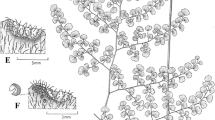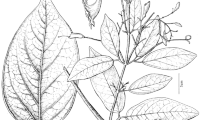Abstract
Polyscias munroi Lowry & G.M Plunkett is published as a replacement name (nomen novum) for the invalid name Polyscias racemosa (C.N. Forbes) Lowry & G.M. Plunkett (Araliaceae), a later homonym of P. racemosa (Drake) R. Vig. [=P. paniculata (D.C.) Baker].

Similar content being viewed by others
Literature cited
Eibl, J. M., G. M. Plunkett & P. P. Lowry II. 2001. Evolution of Polyscias sect. Tieghemopanax (Araliaceae) based on nuclear and chloroplast DNA sequence data. Adansonia, série 3, 23: 23–48.
Forbes, C. N. 1917. New Hawaiian Plants. IV. Occasional Papers of the Bishop P. Bishop Museum 6, No. 4: 51–54.
Lowry, P. P., II & G. M. Plunkett. 2010. Recircumscription of Polyscias (Araliaceae) to include six related genera, with a new infrageneric classification and a synopsis of species. Plant Diversity and Evolution 128: 55–84.
Munro, G. C. 2007. The Story of Lana`i. Native Books, Honolulu, Hawaii.
Plunkett, G. M. & P. P. Lowry II. 2010. Paraphyly and polyphyly in Polyscias sensu lato: molecular evidence and the case for recircumscribing the “pinnate genera” of Araliaceae. Plant Diversity and Evolution 128: 23–54.
Plunkett, G. M., P. P. Lowry II & N. V. Vu. 2004. Phylogenetic relationships among Polyscias (Araliaceae) and close relatives from the Indian Ocean basin. International Journal of Plant Sciences 165: 861–873.
Plunkett, G. M., J. Wen & P. P. Lowry II. 2004. Infrafamilial relationships in Araliaceae: insights from plastid (trnL-trnF) and nuclear (ITS) sequence data. Plant Systematics and Evolution 245: 1–39.
Plunkett, G. M., P. P. Lowry II & M. K. Burke. 2001. The phylogenetic status of Polyscias (Araliaceae) based on nuclear ITS sequence data. Annals of the Missouri Botanical Garden 88: 213–230.
Sherff, E. E. 1952. Munroidendron, a new genus of Araliaceous trees from the Island of Kauai. Botanical Leaflets 7: 21–24.
Acknowledgments
We are grateful to Alice Tangerini for preparing the color plate, to Kenneth R. Wood and John Obata for allowing us to use their photos of Polyscias munroi, and to David Lorence for his helpful review of the original version of our manuscript.
Author information
Authors and Affiliations
Corresponding author
Ethics declarations
Conflict of interest
GMP is Editor-in-Chief of Brittonia, but was not involved in the peer review of this article or the decision to publish, which instead were handled through the Managing Editor. The authors declare that they have no known competing interests that could have appeared to undermine the objectivity or integrity of the work reported in this paper.
Rights and permissions
Springer Nature or its licensor (e.g. a society or other partner) holds exclusive rights to this article under a publishing agreement with the author(s) or other rightsholder(s); author self-archiving of the accepted manuscript version of this article is solely governed by the terms of such publishing agreement and applicable law.
About this article
Cite this article
Lowry, P.P., Plunkett, G.M. & Wagner, W.L. Polyscias munroi (Araliaceae), a new name for a distinctive Hawaiian endemic. Brittonia (2024). https://doi.org/10.1007/s12228-024-09773-3
Received:
Revised:
Accepted:
Published:
DOI: https://doi.org/10.1007/s12228-024-09773-3




